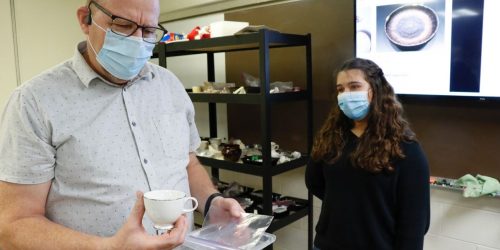
Piece by tiny piece, they then glued their object lessons back together. In the end a touch of golden or silver powder highlighted a fusion of brokenness and grace. Bible teacher Alvin Glassford hopes that each piece will serve as an encouraging reminder to place our broken pieces in the hands of our loving Redeemer and Friend.
Kintsugi, or Kintsukuroi — poetically translates to mean “golden joinery” — is a traditional ceramic repair usually done by rejoining ceramic pieces with a camouflaged adhesive.
Pastor Glassford acquired a porcelain or fired clay item for each of his Friday morning Bible class students. He then used the lesson of Jesus representing the Rock of Salvation, in that when we fall on Him, self will be broken. (Many stay away from Christ for this reason alone.) With this in mind, students placed their Kintsugi projects in Ziploc bags and dropped them on a hard slab of concrete, threw them against a brick wall or smacked them on the school sidewalk. After smashing the item, students would then, piece by tiny piece, glue their object lessons back together. In the end, a touch of metallic powder highlighted a fusion of brokenness and grace.
Kintsugi art of fixing broken pottery is a centuries-old Japanese art technique that uses a special lacquer dusted with powdered platinum, silver or gold. Once completed, the conspicuous cracks of the ceramic pieces glint a golden color emphasizing the beautiful seams, creating a one-of-a-kind appearance to these “repaired” pottery pieces.
Kintsugi art often makes the repaired piece even more beautiful than the original, restoring it with a new look and giving it a second, more beautiful life. This unique art celebrates each artifact's unique history by emphasizing its fractures and breaks instead of hiding or disguising them.
Glassford made the connection of art and the Bible by illustrating that Jesus artfully crafts the broken pieces of our lives, resulting in a deeper beauty made possible by His divine grace on display in our many redemptions. But we have this treasure in jars of clay to show that this all-surpassing power is from God and not from us (2 Corinthians 4:7).
The goal of the lesson is that each piece will serve as an encouraging reminder to the students to place their broken pieces in the hands of our loving Redeemer and Friend. You will also be a crown of beauty in the hand of the Lord, and a royal diadem in the hand of your God (Isaiah 62:3).
As part of the class assignment, students wrote reflection papers on how the Kintsugi project was a great metaphor to use when talking about one’s life and the impact that God can have on it.
In her paper, Samantha Woolford-Hunt, a junior wrote: “One of the many powers that God has shown to us time and time again is the power to heal one's life and put our broken pieces back together again. In our day to day lives God has shown us that He was there in the beginning, He's there now, and He will be there in the future to pick you up and put you back together.”
While Clair Yang, another junior, penned: “When we are broken just like the pieces, He promises that He will give us strength so we can have courage to believe He will do all things for us. Even though Satan will stomp on us to be broken into pieces, God will put each of us together into His arms and protect us. When we are in God’s hands, He will create a new world for us, where we will not be broken and be together away from sin.”
Steve Atkins, Biology and Earth Science teacher, Andrews Academy